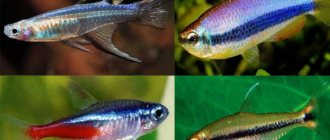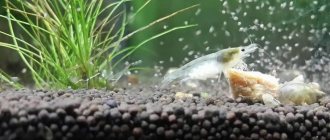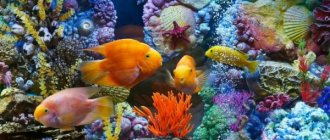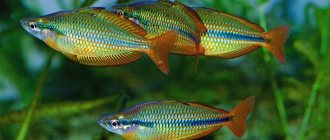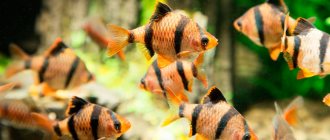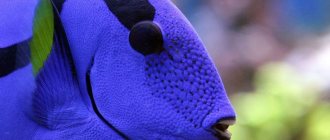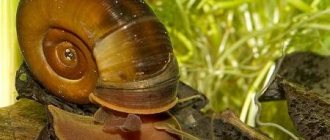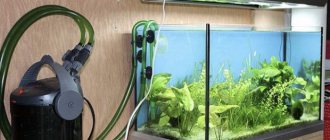Yes, of course, bettas are hardy fish; in their natural habitat they live in muddy, silty, oxygen-free rice fields. But this does not mean that they can be kept in a small glass of water. Firstly, because the conditions of keeping any animal should be as close as possible to natural living conditions. Monkeys must jump in trees, birds must fly, and fish must swim! When a cockerel fish just hangs in a glass with its fins down, it’s actually a sad sight. Secondly, in a glass, vase and other small vessels there is no biobalance . In a rice field, for example, various biochemical processes occur that clean the water from various poisons (ammonia, nitrites and nitrates), but in a glass of water these processes are absent, the poisons accumulate, the fish’s immunity weakens and it dies. Biological balance in artificial conditions can only be achieved in aquariums with filtration, aeration, stable temperature conditions and other attributes of a “normal aquarium”.
Cockerel fish photo
So, the minimum volume of an aquarium for bettas should be 5-10 liters. You can put a mini-filter in such an aquarium, such an aquarium can be beautifully arranged in a natural way, you can plant aquarium plants, adjust the biobalance, and caring for such a reservoir is much easier than washing the “pot” every week, while causing enormous stress to the fish.
Cockerel fish photo
The modern aquarium market provides a wide selection of nano-aquariums for bettas. There are aquarium cubes, there are balls. For example, the Tetra cascade globe is interesting because it is equipped with a waterfall filter, which filters and aerates the aquarium.
Such an aquarium will be an excellent home for a betta; it can be properly and beautifully furnished. The only thing you need to buy is an inexpensive mini heating pad to maintain a stable temperature, for example, this one . And this is not necessary if in winter the room where the aquarium is located is constantly warm.
Very often, cockerels are taken into children's aquariums. If this is your situation, we recommend that you look at this material .
Personally, we are only for children to be involved in the aquarium hobby from a very early age. Such aquarium installations are a form of play for children. It is important here that parents themselves study the basics of aquarium keeping and set up the aquarium correctly from the very beginning. This will be the key to the child’s success and joy.
History of fighting fish and natural habitat
The Siamese betta is native to the waters of Southeast Asia, Indonesia and China. The first written data about betta dates back to the beginning of the 19th century. Fishermen of Siam (modern Thailand) noticed a small fish that was very aggressive towards its relatives.
The first specimens caught were not particularly bright and had a small, inconspicuous body with short fins. Short breeding work made it possible to develop the Pla Kat species, which translates as “biting fish.”
In the mid-19th century, several specimens of the new type were given by the royal family of Siam to Doctor of Biological Sciences Theodor Cantor for scientific description. The scientist gave it the name Macropodus pugnax, which was later changed to Betta splendens, which can be translated from Latin as “beautiful warrior.”
In the late 19th and early 20th centuries, the Siamese betta appeared in France, Germany and the United States of America. Here, a new color species of fish is soon hatched, called Betta cambodia.
The Siamese cockerel most likely came to Russia thanks to the famous aquarist Desnitsky. Although, according to another version, another professional V. Melnikov began breeding labyrinth fish for the first time in Rus'.
In China, children collected fish from swampy ponds. In an hour it was possible to catch up to 50 pugnacious cockerels. Then the audience staged water fights between them.
Pla Kat was developed for licensed fights. The winner was considered the individual who, even after several hours of fighting, showed readiness for the next fight. These were no longer just cruel games of children, the stakes in these games were very high. Sometimes entire families ended up on the street as a result of the loss of the head of the clan.
In Siam, this business has long been supervised by the royal family. And until now, fighting fish is grown here for licensed games.
Photo gallery:
History of appearance
Beta is the oldest freshwater species kept in captivity after the Goldfish. Aggressive fish were discovered in the 19th century. in Siam and in reservoirs in southeast Asia. Enterprising aquarists, crossing wild cockerels, got “biting fish”, which they called Pla Kat. Betta splendens has been named since 1909.
Appearance
Betta fish are labyrinthine fish with an oval, laterally flattened, and elongated body. The length is 4-6 cm, sometimes a betta fish of 10 cm is found. The tail of the cockerel, similar to a lush veil, and the upper fins are rounded, and on the chest they are pointed. The line of the lower fin runs along the entire abdomen.
The color of the rooster fish is varied: some are completely one color, others are two-colored, and others are multi-colored, like a rainbow.
It is curious that the color of the betta becomes brighter during the spawning period and during the fight.
Where do they live in nature?
The betta fish chooses warm and shallow fresh water bodies for its habitat, even puddles, often muddy and polluted, muddy rivers where the current is slow. Betta fish are found in rice fields flooded with water without oxygen, and sometimes even inhabit drains. The cockerel is a fish that has adapted to breathe air from the atmosphere with the help of a labyrinth - a special organ. The cockerels were born in the reservoirs of Southeast Asia.
Fish fights
Male betta fish do not tolerate rivals in a small territory, and start fights when the loser must die. When attacking, the cockerels open their mouths wide and sink their sharp, thin teeth deeply into the body of their fellow. The winner does not allow the defeated fish to take a breath of fresh air and it dies.
No matter how brutal the skirmishes may be, betta splendens show nobility and do not attack the enemy rising to the surface, allowing the cockerel to take a breath of air. When three males cross, two fight, the 3rd fish waits for the winner.
Description
The Siamese betta belongs to the macropod family and is a labyrinth fish. This means that its structure contains a special organ (labyrinthine), which allows it to breathe not only with gills under water, but also with atmospheric air. This individual must always have free access to the surface so as not to die from suffocation.
Female fighting fish reach a length of 4 cm, males - 5 cm.
The first wild representatives of the species had a grayish or greenish coloration. Depending on the emotional state of the individual, darker stripes appear on its body, which can be located both along and across.
Now the types of Siamese cockerel are diverse and amaze with their color variations - scarlet, azure, topaz, turquoise, pink, snow. Macorpods are one of the most beautiful inhabitants of the aquarium. At the same time, the cycloid scales have such a structure that it allows the light falling on it to shimmer, changing shades.
This feature is more characteristic of males during spawning or skirmishes with other individuals. Females are paler, smaller, usually with short fins.
Varieties
Selected species of Siamese cockerel can, first of all, be divided according to color into:
- Single color.
- Bicolor.
- Multicolor (multicolor). Usually the body is one color, and the fins shimmer in many shades.
The main classification of artificially created species is based on the variety of body shapes and fin sizes.
Veiltail
The veiled or veil-tailed cockerel (Betta Splendens VT) is the very first artificially bred type, which served as the basis for further breeding work. Body color is varied. It has a beautiful and large tail in the form of a veil.
Half Moon
The crescent cockerel has a large tail, the outer plumage of which forms a semicircle. The remaining fins are also abundant, large, and veil-shaped. The color is usually bicolor. There are several types of Betta splendens HM:
- The Halfsun (Betta Splendens CTHM) is the result of the hybridization of a common Crescent and a Crowntail.
- Feathertail - a tail in the form of a bunch of bright feathers.
- Rosetail (Betta Splendens RT) - the tail feathers are intertwined, forming as if rose petals.
Crowntail
Betta splendens CT or crown-tailed betta has a tail that resembles a royal crown. There are cockerels of this species with single, double and crossed rays.
Two-tailed cockerel
Betta splendens CT is distinguished by a tail fin that consists of two halves.
Roundtail
The round-tailed betta is very similar to the wild type of fighting fish, differing from it only in its rounded fins.
Speartail
The brush-tailed or spear-tailed betta (Betta splendens ST) has an original tail that looks like a spear or a bright brush.
Shorttail
The poster cockerel (Betta splendens PK) has a short and wide dorsal fin. There is also a separate species - the poster crowntail.
Delta
The delta-tailed betta (Betta splendens D) is similar to the veiltail. It is distinguished by a very hard caudal fin, forming a triangle when the fish moves. It looks like the Latin letter D, its outer rays form an angle of 130 degrees.
Superdelta
Betta splendens SD is distinguished by a tail angle of 130 to 180 degrees, an intermediate species between crescent and delta.
Giant
This variety is also called the royal or giant cockerel due to its large size, up to 8 cm. There are several types:
- poster giants;
- crescent;
- short-tailed;
- veiled giants.
The Dragon
The dragon fighting fish is not distinguished by the shape of its fins; their size is not important. This individual has a powerful, massive body with hard chainmail scales of a bright, often bicolor, color. For example, scarlet and white or graphite and turquoise.
elephant ear
Dumbo has a graceful body and massive fins of a characteristic shape.
Crest
The combtail or comb-tailed betta has tail feathers that resemble the teeth of a comb.
Variety of colors of cockerels
Red Royal
This type requires carotenoids in the food to maintain the bright color of its scales. Despite the characteristic smoothness and regularity of movements, the cockerel is aggressive and does not get along well with other breeds and males of its species.
Black
Has a peaceful disposition. In addition to black, the body color contains blue tones, and red and blue stripes are visible on the delta-shaped tail.
Piebald
This form of betta has a lightened head that contrasts with a plain body. The piebald trait is found in marbled and butterfly colored fish.
Emerald with green body
There are blue iridescent blotches on it. The ventral fin is red with a white edge, the rest are multi-colored. The cockerel is not a selective breed; it lives in Asian natural reservoirs.
Blue with veil long fins
On the blue scales, the head stands out as a dark spot, and the brightness of the red ventral fins.
Cambodian
With bright red or green fins, contrasting against the background of a whitish body.
Marble
These cockerels have green and blue spots scattered in a chaotic manner over their white scales and fins.
Draconian
The dragon-colored cockerel has contrasting colors, a wide strong body, and short fins. Large scales resemble chain mail with a metallic sheen.
Multicolor
Bright, attracting attention with a variety of colors of the rainbow spectrum in color and various outlines of inclusions.
Mask
Cockerels of this breeding form are classified as monochromatic. Only the head stands out, darker than the body.
Butterfly
The Betta fish received this name due to the translucent fins on its body of a single color.
Among single-colored cockerels, there are selection forms of white, orange, gold, purple, and blue.
What distinguishes cockerels from other ornamental fish is their variety of shapes and bright colors.
The largemouth cockerel stands apart from other classifications. The name speaks for itself. The distinctive characteristics of the fish are a large mouth and a relatively short tail.
Features of behavior
The strikingly beautiful appearance of the aquarium betta is in sharp dissonance with its fighting character. It is difficult to imagine that such a gentle creature, reminiscent of a water angel, is capable of fighting with its brothers for hours.
Males come into conflict with each other instantly and for any reason - because of a female, food, river. For this reason, you should not stock two male bettas in the aquarium.
Females are much calmer and usually treat each other friendly. But it is not always possible to predict their tempers.
The best combination for one pond is one male and a pair of females.
The male betta does not treat other inhabitants of the aquarium in the best way. Therefore, it is necessary to select neighbors for him extremely carefully.
The warlike temperament demands battles, even if there is no opponent nearby. Some of the more aggressive specimens can spend hours fighting with their reflection in the glass of the aquarium. But it is necessary to populate the pond with other fish; some of the species make the betta’s character much more peaceful and have a beneficial effect on the situation in the home pond. It's all about the right neighborhood.
How to distinguish a male from a female betta
Adult betta fish have fairly distinct sex differences. The male is larger, has a brighter color, and has longer fins. Until 2 months of age, it is much more difficult to distinguish a female from a male, but there are still several differences:
- the female has a wide and round ventral fin;
- a more rounded abdomen, on which the ovipositor (white dot) is visible;
- she is calmer and less aggressive.
Aquarium maintenance of a Siamese betta
The betta fish is not at all difficult to maintain and care for if you follow the basic requirements.
Water
Betta is a tropical inhabitant, so the water in an artificial reservoir must be heated at least +24...+28 °C.
Betta fish loves soft water; its hardness should be between 5-15 °dH. Therefore, before pouring it into a reservoir, the liquid needs to sit for at least a couple of days and be heated. It must be updated, changing 1/3 of it weekly. For large aquariums - once every 3 days. The optimal acidity indicator is pH 6-8.
The minimum aquarium size for one couple is 5 liters.
Cleaning the pond
It is better to remove leftover food daily. Carry out thorough cleaning regularly, at least once a month, without using chemicals.
It is better to remove algae and plaque from walls and decorative elements with a soft sponge. In this case, the fish should be placed using a net.
You can use any filters, both internal and external. They should be washed as they become dirty, preferably at least once a month.
A couple of times a year you need to organize a general cleaning of your home pond with a complete rinsing of the soil, plants, and filters.
Air
The Siamese betta is a labyrinth fish and needs free access of air. Therefore, it is necessary to ensure that a film does not form on the surface of the water. You should also remove overgrown plants.
The betta fish is an active inhabitant of the reservoir, capable of jumping high and even falling out of the tank; it is better to cover it with a special lid or net.
Mr. Tail recommends: vegetation and decor
It is much easier to decorate a home pond with artificial plants, but natural aquatic plants are still needed for a normal biosystem. In addition, betta fish love to make nests in them when it is time to spawn.
You can plant unpretentious higher plants in the ground - elodea, hornwort, vallisneria, Thai fern or water cabbage. Calcined river sand or boiled small pebbles should be poured onto the bottom.
When arranging an artificial reservoir for betta fish, it is advisable to try to completely recreate the natural environment. To do this, the aquarium is decorated with grottoes, driftwood, beautiful stones, and halves of coconuts.
A gap under the lid is necessary; an air gap of 5-10 cm should be left to the surface of the water so that the cockerels can breathe using the labyrinth organ. The protection will at the same time protect the batta from jumping out, and in addition will help to retain air.
In order to regulate lighting in the aquarium, lamps with a warm spectrum should be placed. Cockerels need long daylight hours.
Other tips
Betta fish love to be petted and are happy to allow this to be done. But you should be careful not to remove the special mucous protective film from the scales when touching it; it protects the cockerels from many diseases.
Do not be alarmed if the cockerels lie at the bottom of the reservoir; this is how they rest. Of course, such periods should not be long.
Bettas are active inhabitants of the aquarium, and if they behave strangely, do not rear up, swim passively, sideways or turn upside down, you need to sound the alarm and treat your pets.
Male cockerel Veiltail blue (size XL)
Veiltails - Betta Splendens - a common betta fish with an elongated, slender, almost round body in cross section. Upper mouth, swollen lips. The males of these fish have caudal, anal and dorsal fins that are long and pointed at the end. In the female cockerel they are round in shape. The anatomical features of bettas, like other fish of this genus, include the so-called labyrinth, which is an epibranchial bone formation with a large number of canals covered with a mucous membrane rich in blood vessels. This organ appeared as a result of adaptation to life in oxygen-poor water. The fish in such water swims to the surface and swallows air with its mouth. Air entering the labyrinth releases the oxygen it contains through the blood vessels of the labyrinth mucosa. In this way, atmospheric respiration of these fish occurs in water with a low oxygen content.
Color: Cockerels have different colors.
- Solid - Red, Blue, Green, Wild-Type, Cellophane / Pastel, Opaque, Yellow & Pineapple, Orange Orange, Orange Dalmatian, Black, Purple, Mustard Gas, Chocolate, Copper and the very rare Albino variant.
- Bicolor - the body is one color, and the fins and/or tips of the fins are another.
— Multicolor “multicolor” - body and fins of different colors, and the fins can have several transitional color shades: from light to dark and vice versa; There are fish with a dark head and front part of the back, and the rest is much lighter.
Size: Up to 6 cm, lives up to 3 years in an aquarium.
Content level: Easy.
Feeding: Consumes live food - bloodworms, tubifex, coretra, brine shrimp, daphnia - and other types of frozen, live and dry food. You should not overfeed bettas, as they are prone to obesity (especially in small aquariums where there is not enough space for swimming). You can also periodically arrange fasting days for betta fish (do not feed 1 day a week).
Behavior and character: One of the names of the fish is betta. She received this name for her quarrelsome disposition and cockiness towards both her relatives and representatives of other species. A fight can also be provoked by the appearance of a new neighbor and the addition of fresh water to the aquarium, which is a signal for reproduction. If you keep a betta fish in a community aquarium from juvenile age, its aggression decreases. Cockerels can be kept with peaceful species of medium-sized fish and small active ones, but in no case with veil-shaped fish - their tails and fins will be quickly plucked. Two adult male cockerels cannot be kept in the same aquarium - with age they become pugnacious (for 1 male there must be at least 60 cm of aquarium length). It is better to keep 1 male with several females, worse is a pair, because... the male will constantly pursue the female who is not ready for spawning.
Compatible : Neons, Rhodostomus, cardinals, mollies, platies, speckled catfish. Plaecilia, neon iris, ancistrus, swordtail, black molly, grunting gourami, ornathus ornathus, acanthophthalmus, otocinclus, pulchrypinnis, minor, rubrostigma, rasbora, ternetia, brocade catfish, congo, botia, tarakatum, loricaria, oturisoma, platidoras, Siamese algae eater , befortia, gastromyzon, speckled catfish
Compatible, subject to certain conditions: Neon, guppies, macrognathus, zebrafish, labeo, cardinal, angelfish, lalius, ctenobrycon, barbs, spotted gourami, marbled gourami, pearl gourami
Aquarium: Cockerels are not picky about the size of their home. An aquarium of 4 - 6 liters is enough for one cockerel; aquariums of 50 liters in volume and a water level of up to 12 centimeters, the length of which is significantly greater than the width, are best suited for a couple. The aquarium must be closed at the top so that there is warm air above the surface of the water, because... otherwise, the fish, taking in cold air, may catch a cold. The fish can also jump out. If you are considering a small aquarium for a betta fish complete with filter, pay attention to the Tetra Cascade Globe series
Aeration and filtration:
Bettas are not picky about the oxygen content in the water, so additional aeration is not required, but will be useful in terms of mixing the water. A filter never hurts, the main thing is that it does not create a strong current - cockerels do not like this.
Decoration of the aquarium: Quite dense thickets of soft plants (cabomba, myriophyllum, cryptocoryne) are recommended - cockerels love to “lie down” on branches - and the presence of free places for swimming. It is desirable to have plants floating on the surface, such as riccia or trilobed duckweed. Thickets of plants and snags will provide females with shelter from the pursuit of males. Artificial plants and decorations should not have sharp edges that could damage long fins. The soil is dark - against its background, aquarium bettas better retain their dark, bright color.
Content: 23 - 26°C. A decrease in temperature leads to various diseases. GH 6 - 15°, pH - 7. Water should be well settled. A weekly change of 25% of the water to well-settled water is required.
Sexual differences: The male differs from the female in having brighter colors and longer fins. The female cockerel has a slightly more modest coloring and fins that are not as lush as those of the males. Near the anus, the female has a small formation resembling an egg. Males become adults at the age of four to six months. To successfully breed betta fish for spawning, you need to take a pair at the age of 6 - 8 months. At this time, males do not yet have luxurious fins, but they are very active, and females are just approaching puberty. Old females who did not spawn at a young age develop a blockage of the genital opening and are unable to spawn. After a year, although the cockerels spawn, the offspring are usually poorly cared for.
Preparation for spawning: About two weeks before spawning, it is advisable to separate the female from the male. The appearance of a partner also stimulates spawning. In the period before spawning, spawners must be fed with bloodworms, since feeding with daphnia and cyclops can lead to the consumption of juveniles.
Spawning aquarium: Spawning aquarium with a length of 25 cm for a couple, without soil, with dim lighting, with a dark substrate and a layer of water of 7 - 11 cm. It is better that the length of the aquarium exceeds its width. Hardness 4 - 15°, pH 6 - 7.5, temperature 26 - 29°C. Aeration is required. It is advisable to add 1/3 of fresh water to the spawning area, throw a bunch of river grass on the surface of the water, and arrange thickets of plants in one of the corners. Riccia will help the male build a nest from air bubbles, and the thickets will help the female, who is not ready for spawning, to hide from an overly persistent male. Sometimes there is not enough grass, then the female is fenced off from the male with glass, which is removed only when the female herself shows by her appearance that she is ready to spawn. First, a male is placed, and after a couple of hours, a female with a swollen belly is placed next to the male. The male builds a foam nest on the surface of the water, under which spawning occurs, then he cares for and protects the eggs and larvae from other fish (while courting the offspring, he must be well fed with bloodworms or well-washed tubifex). The water temperature is raised by 2 - 3°C (from t for keeping). During spawning, the male wraps his body around the female’s abdomen in a ring-like manner and squeezes out one to three eggs. Then he fertilizes them and picks them up with his mouth and places them in the nest. After this, he returns to the female and spawning is repeated. 100-600 eggs are hatched, with an incubation period of 1-2 days. After the end of spawning, the female must be removed. If the female is not removed, then in a small aquarium the male will become very agitated and may even kill her.
Offspring: On days 3 - 5, the larvae take a horizontal position and spread throughout the aquarium. After the fry take a horizontal position and begin to swim, the male must be removed because his paternal instinct disappears and for him the offspring turns into food. The water level is lowered to 5 cm or the fry are transferred to a nursery aquarium with the same water level, which is then increased as the fry grow. In the first days, while the larvae feed on ciliates, you need to maintain a high temperature (plus 25 - 27 degrees), then you can gradually reduce it. At first, the larvae breathe only oxygen dissolved in water, so for three to four weeks (until the small bettas develop a labyrinth), you need to take care of the cleanliness of the water in the aquarium. At a temperature of 28 °C, the fry grow quickly and by the third month the veil of the fins of the males becomes noticeable. But fish raised at such a high temperature are prone to colds; more resistant juveniles are obtained when raised at 25 ° C.
Features: If a male cockerel lives alone, you can periodically place a mirror on him. The cockerel is a fighter by nature, he is territorial and protects his territory. One of the techniques for protecting its territory is to show a “fighting stance” - by inflating its gills and fluffing its fins, the cockerel tries to show its superiority to the enemy; also, with its fluffed fins, the male cockerel invites the female under its nest. By placing a mirror in front of the male, you are thereby showing the “rival” cockerel. The natural reaction of a healthy betta to a mirror is inflated gill covers and maximally expanded fins. Using a mirror, HM (half moons) are trained so that the tail fin does not get pinched and turns into the correct D. In this case, the betta should be placed on the mirror for 1 - 2 hours a day. You should not constantly leave a mirror near the aquarium with a cockerel - the constant “presence of a rival” causes stress in the cockerel, and in the future discourages the desire to perform a “fight dance”. Using a mirror you can also assess the well-being of a cockerel; a sick cockerel will not show any interest, and in some cases will rush to hide, feeling its inadequacy at the moment. For training, use a small mirror so that the betta has the opportunity to hide from his own reflection.
Diseases and prevention
The lifespan of Siamese cockerels is not too long - 3-4 years. But diseases can significantly shorten the life of beautiful pets. You should carefully monitor their health status, carry out preventive measures in a timely manner and promptly treat them.
Prevention of fish diseases is to keep the reservoir clean and the biological system in balance. The quality of food is also very important. If this is live food, then before placing it in the aquarium it must be thoroughly rinsed under running water.
A good prevention of disease in males is regular vitamin supplementation.
In addition to strange behavior, bloating and general lethargy, damage to the fins and scales is an alarming symptom. With some diseases, real holes appear on them.
You should also sound the alarm if the scales are unnaturally protruding or the fins are constantly pressed down. If any unfavorable signs appear, the sick fish should be removed and intensive therapy should begin. The most common pathology affecting cockerels is considered to be fin rot. It is caused by a bacterial infection. The disease can be introduced into a reservoir along with bottom filler, live food or infected fish. The fins sag alarmingly and appear to be burned along the edging line.
If there is no timely treatment, the cockerel may completely lose its luxurious plumage.
There are known cases of fighting fish being affected by other pathologies, for example, dropsy, tuberculosis, oodiniosis, ichthyophthyriosis, and fungus.
Health and life expectancy
Under good conditions and proper care, betta fish live for about 3 years. If hygiene is not observed, they develop the following diseases:
- Fin rot. The disease, the causative agent of which is the Pseudomonas bacterium, develops when kept with infected fish or plants, as well as due to feeding contaminated food and lack of quality cleaning in the aquarium. It begins with dulling and erosion of the fins and leads to their rotting and disintegration. The disease is treated with streptocide and salt baths. It is also necessary to disinfect the aquarium, replace part of the water, and wash the vegetation and substrate.
- Costiosis. The causative agent of the disease is the flagellate parasite, brought into the aquarium by infected fish or with live food. It manifests itself as clouding of the skin and a gray spot with copious mucus secretion. Costiosis is treated with malachite green and furazolidone, as well as daily replacement of 20-30% of the total volume of water.
- Ichthyophthyriosis. Infection occurs through contact with infected fish, plants or live food. A sick individual becomes lethargic, refuses food and swims in jerks. Small white dots appear on her head, resembling semolina and spreading throughout her body. For treatment, salt baths, Bicillin 5, malachite green and Antipar are used.
- Dropsy. The pathology develops against the background of infections and due to improper feeding of the pet. A sick individual experiences apathy, loss of appetite, raised scales, bloating, redness of the abdomen and fins. Dropsy is treated with a weak solution of potassium permanganate, streptocide and Bicillin 5.
Cockerels are bright labyrinthine fish with a catchy appearance and a cocky character. They do not require complicated care and will decorate any home aquarium.
Feeding
Bettas, despite their small size, are very voracious, but unpretentious in their choice of food and can eat almost anything. Therefore, you can use food in any form - dry, live or frozen. But if an aquarist wants beautiful pets to please their household for as long as possible, it is advisable to correctly plan their diet.
Most of the food should be given to live food. This could be bloodworms, tubifex, daphnia, crushed earthworms, snails.
Bettas should be given food at least twice a day. But you can’t leave excess of it in the water. Food should be poured in such a quantity that it can be eaten within 20 minutes. After this time, the residue must be removed.
To prevent obesity and overfeeding, it is advisable to regularly, preferably weekly, carry out a fasting day, during which you do not put food into the water at all.
Getting along with other aquarium inhabitants
A male cockerel with a pair of females can get along quite well with viviparous animals - guppies, swordtails, and mollies. It is also advisable to add fast-moving schooling fish to them - barbs, neon, rasbor, thornets.
You should not equip a common pond with slow-moving inhabitants, for example, goldfish, angelfish.
It is strictly forbidden to house aggressive fish, such as piranhas, astronotuses, tetraodons, and cichlids, together with bettas.
Catfish and males are well compatible; they simply will not pay attention to each other. But bettas will quickly eat snails and shrimp.
It is advisable to place all fish - bettas and their future neighbors - in the aquarium together and at a fairly young age. Then there is a greater chance that they will get along.
For all their cockiness, the cockerels have a hard time bearing the death of their neighbors. If this happens, you should not immediately introduce a new fish, the betta may kill it out of grief.
In any case, when adding neighbors to Siamese cockerels, you must carefully monitor their behavior. The main thing is to immediately remove the victims.
Compatibility
Keeping betta fish together with representatives of other species is possible only if you have a spacious aquarium. You also need to take into account the cocky nature of pets.
Betta fish can be housed together with rainbowfish, rasboras, thorns, corydoras and viviparous platies. But goldfish, tetraodons, piranhas and large cichlids are not suitable for keeping with bettas.
Important! It is extremely undesirable to place males in the same aquarium with fish that have long veil fins or bright colors. Such individuals will inevitably become victims of attacks from quarrelsome neighbors.
Breeding
Like all labyrinth fish, bettas build their nest from a kind of foam that the males produce using their own saliva and water.
If it appears, it means preparations for spawning are underway.
Before spawning, the pair must be completely transferred to live food and placed in a special container with a small amount of water (up to 15 cm of water column). It should have a lot of dense plants so that the female can hide from the male attacking her. Java moss and duckweed work well for the surface. The water temperature is increased to +28 °C.
Within two weeks, the female increases greatly in size. Then the male wraps his fins around the female, squeezing eggs out of her (up to 50 eggs at a time) and at the same time processes the clutch with milt. During one spawning, a pair lays up to 200 eggs.
If the male has prepared the nest, but the female is not yet ready, he can beat her to death. In this case, they must be separated from each other by a glass partition.
After successful spawning, the female must be removed so that she does not get hurt and eat the eggs. Now the male will fiercely protect the clutch and take care of it - fanning it with his fins to saturate it with oxygen and remove dead elements, adding foam if it becomes scarce. If a lot of eggs drown, then the future father picks them up and transports them to the clutch. During this period, the lamp should be turned on around the clock so that the cockerel does not fall asleep and the offspring do not die by sinking to the bottom.
How to breed betta fish?
Cockerels reach sexual maturity at 6-8 months of life. This is the pair that is taken to produce offspring.
Spawning of males also happens in a general aquarium, but it is better to transplant a couple of breeders into a prepared container. A small aquarium of 4-5 liters and 15 cm in length is used as a spawning tank. This aquarium is filled with soft, prepared water at a temperature of 28-30 degrees and equipped with a compressor. The water level should not be more than 15 cm. No soil is placed at the bottom of this aquarium; several algae with small leaves are placed in the water.
A small house for the female is equipped in the spawning area so that she can hide from possible attacks by the male.
The male is the first to be placed in the spawning aquarium. He begins to build a nest of air bubbles and small algae, which he holds together with his saliva. He transfers eggs to this shelter, which are spawned by the female. The male moves the eggs into the nest in his mouth. After spawning ends, the male begins to drive away the female and she is removed. The male is transferred to a common aquarium immediately after the babies appear.
The fry of the cockerel are given crushed tubifex and brine shrimp. Dry food is not yet given, since such nutrition has a bad effect on the growth of the fry. After three weeks, the young animals are sorted by size so that large individuals do not eat small ones. After another week, the small fish develop a labyrinthine organ, then the compressor is turned off, they are temporarily placed in separate containers and kept like adults.
Raising fry
After 1-2 days the fry begin to hatch. Until they completely “eat” their yolk sac, there is no need to feed them.
With the appearance of the first babies, the male must be removed to avoid being eaten. The amount of water is reduced by another 5-7 cm, aeration is set to maximum. This is necessary for the entire period of formation of the labyrinthine mechanism in the offspring - 1-1.5 months.
Then the young males can already breathe atmospheric air, so the water level is gradually increased, and its oxygen saturation is reduced using aeration.
Feeding begins with live, but thoroughly washed food - bloodworms, ciliates, Artemia nauplii. You can gradually add boiled egg yolk to your diet.
The growth rates of fry are different. Larger individuals must be gradually removed to prevent cannibalism.
Preparing a mini-aquarium and populating it
Experienced aquarists recommend choosing only spacious aquariums for betta fish; 1 individual should have at least 5 liters of water. The recommended optimal tank volume is from 10 liters. The main criteria for arranging a mini-aquarium:
- The correct choice of aquarium shape is important. It is often practiced to keep a betta in a round aquarium; sometimes jars, glasses or glasses are used. In the last three options, the pet has nowhere to turn around and may die. The round shape of the container is inconvenient to handle; such an aquarium cannot be cleaned with a scraper. Some sources indicate that keeping them in a round bowl is harmful to your pet’s vision and health. It is better to keep your pet in a rectangular container.
- The fish’s home cannot be tightly closed with a lid, since it must remain possible to rise to the surface of the water and breathe. To prevent your pet from jumping out, it is better to use a soft mesh.
- There is no need for aeration and filtration systems due to the peculiarities of the respiratory system of cockerels. The only accessories you should purchase are a small water heater.
- A small amount of soil should be placed at the bottom. For this, any type of gravel, stones, glass beads, balls are used. Items must be free of chemical residues.
- After arranging the soil, plants and small decorations are placed so that they do not interfere with the movement of the fish in the water space. It is better to use artificial plants in a small aquarium, but they should not injure the betta's fins with sharp edges. Live aquarium plants look more beautiful, but in small spaces they quickly spoil the water under the influence of heat, sunlight and other factors. It is best to choose plants made from silk.
- Filtered drinking water is poured into the tank. Distilled water is not suitable because it lacks the minerals your pet needs. Tap water should be dechlorinated first.
- Before introducing your pet into the prepared aquarium, you need to leave it for 24 hours.
- It is recommended to place the aquarium in a quiet place where it is not hot and there is moderate lighting. Intense sunlight will provoke the growth of green algae, the proximity of heating devices will affect the water temperature, and the noise will cause stress to the betta, and fin rot may begin.
A pet bought in a store is placed in a container next to a furnished home so that the water in the containers becomes the same temperature. After this, the container with the fish is lowered into the tank so that the fish can move on its own. You can transfer the fish using a net.

